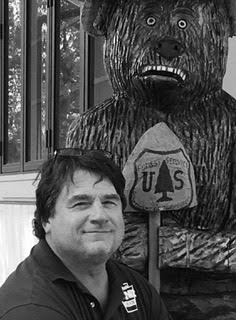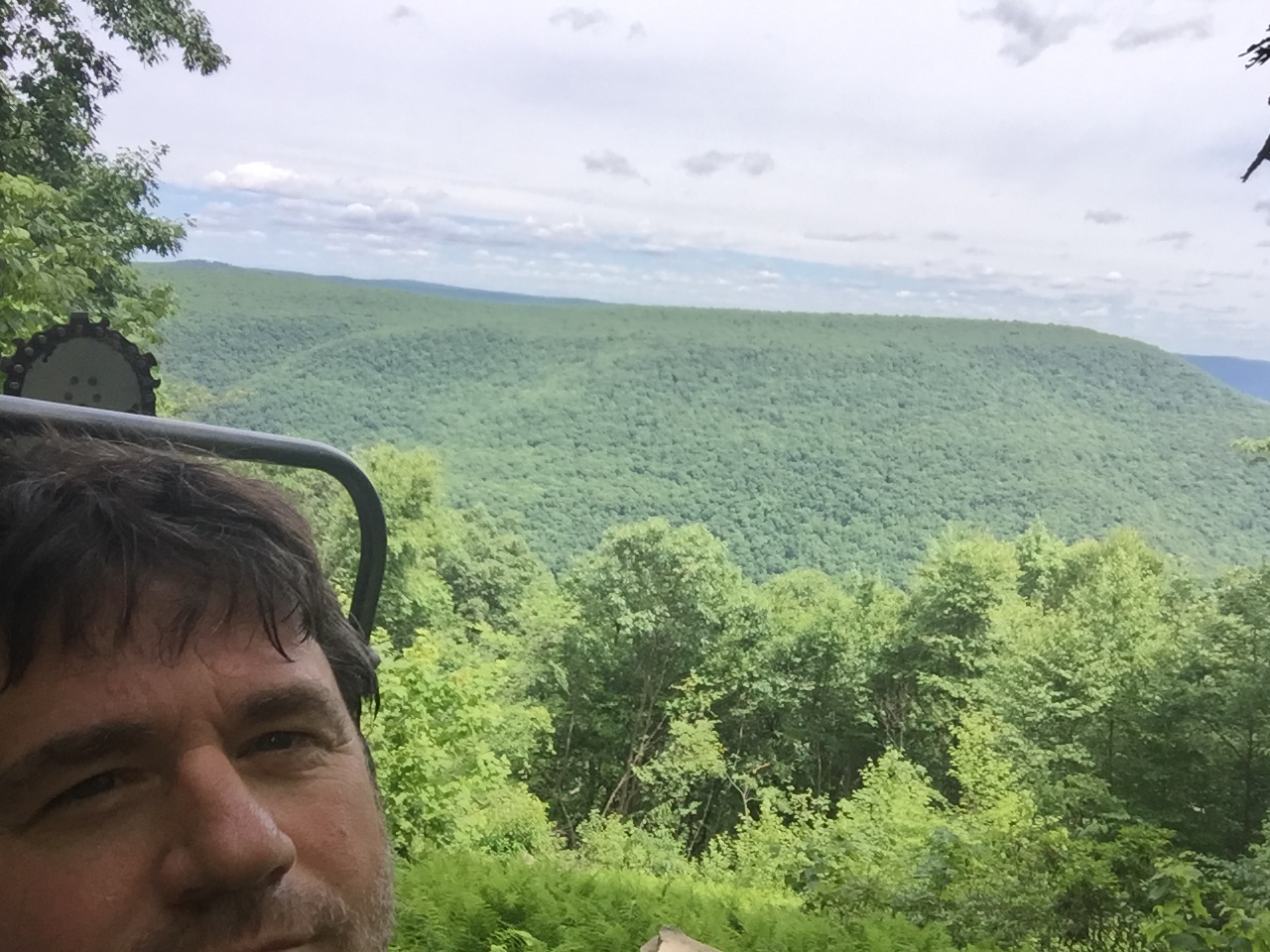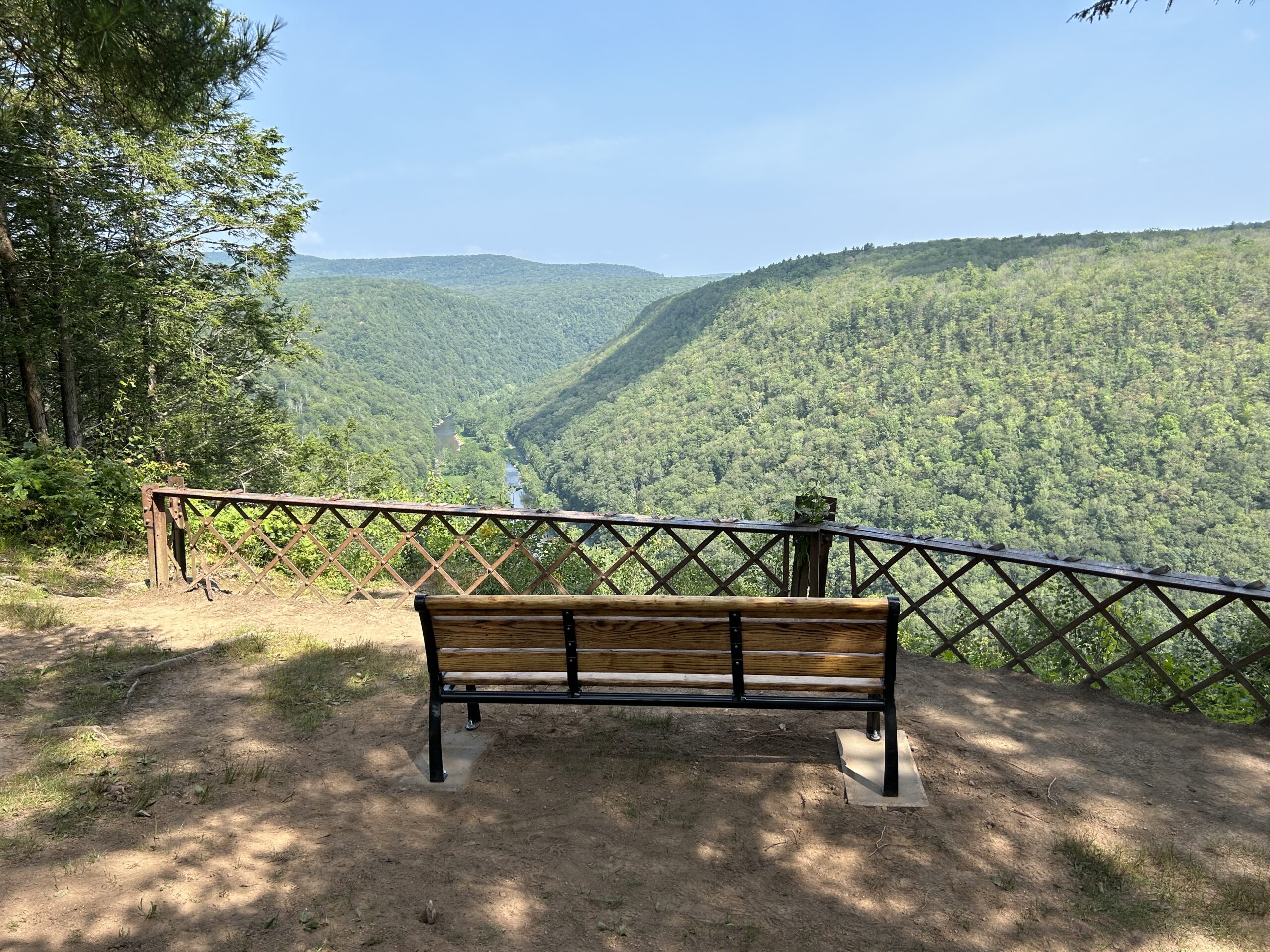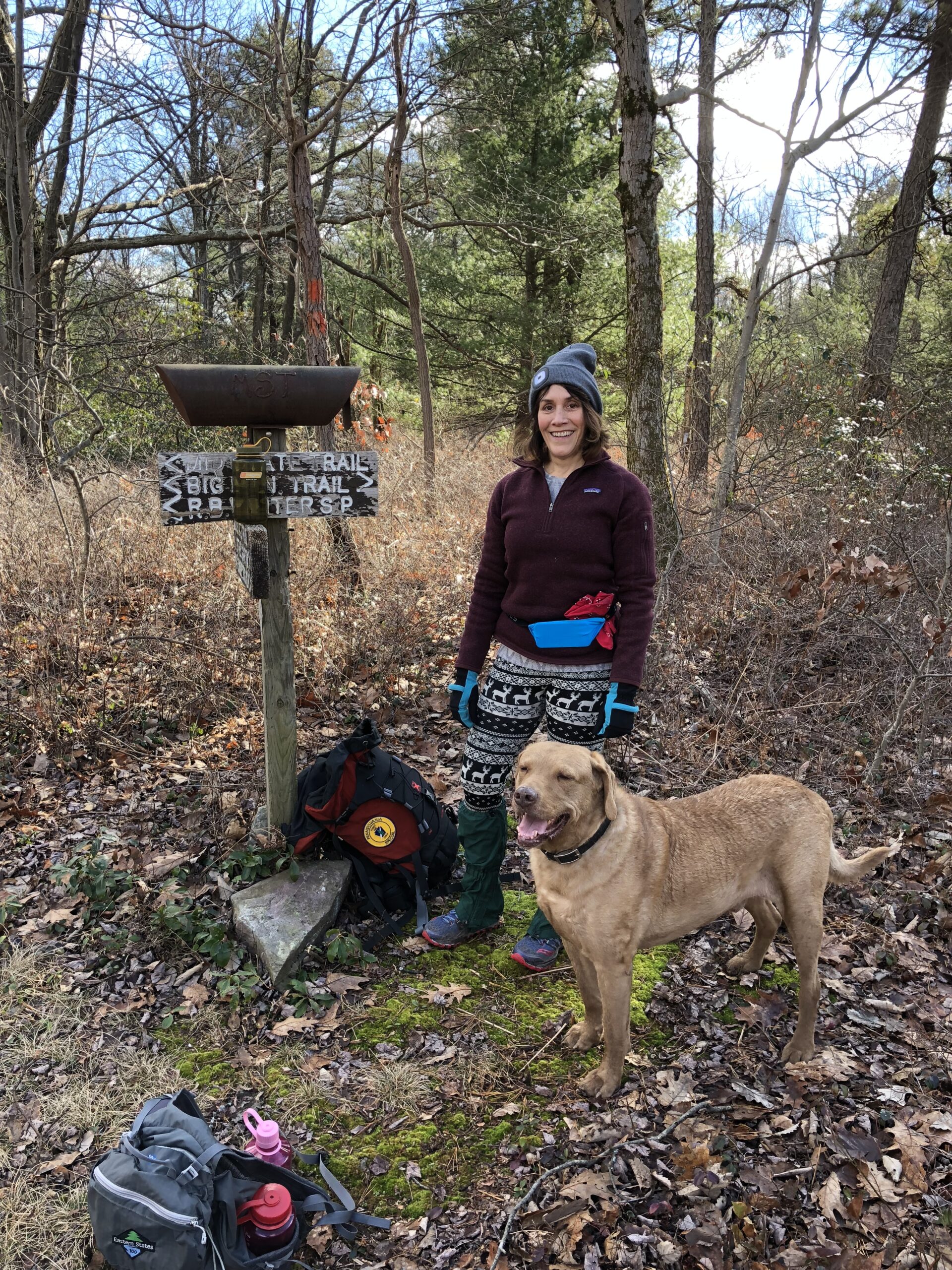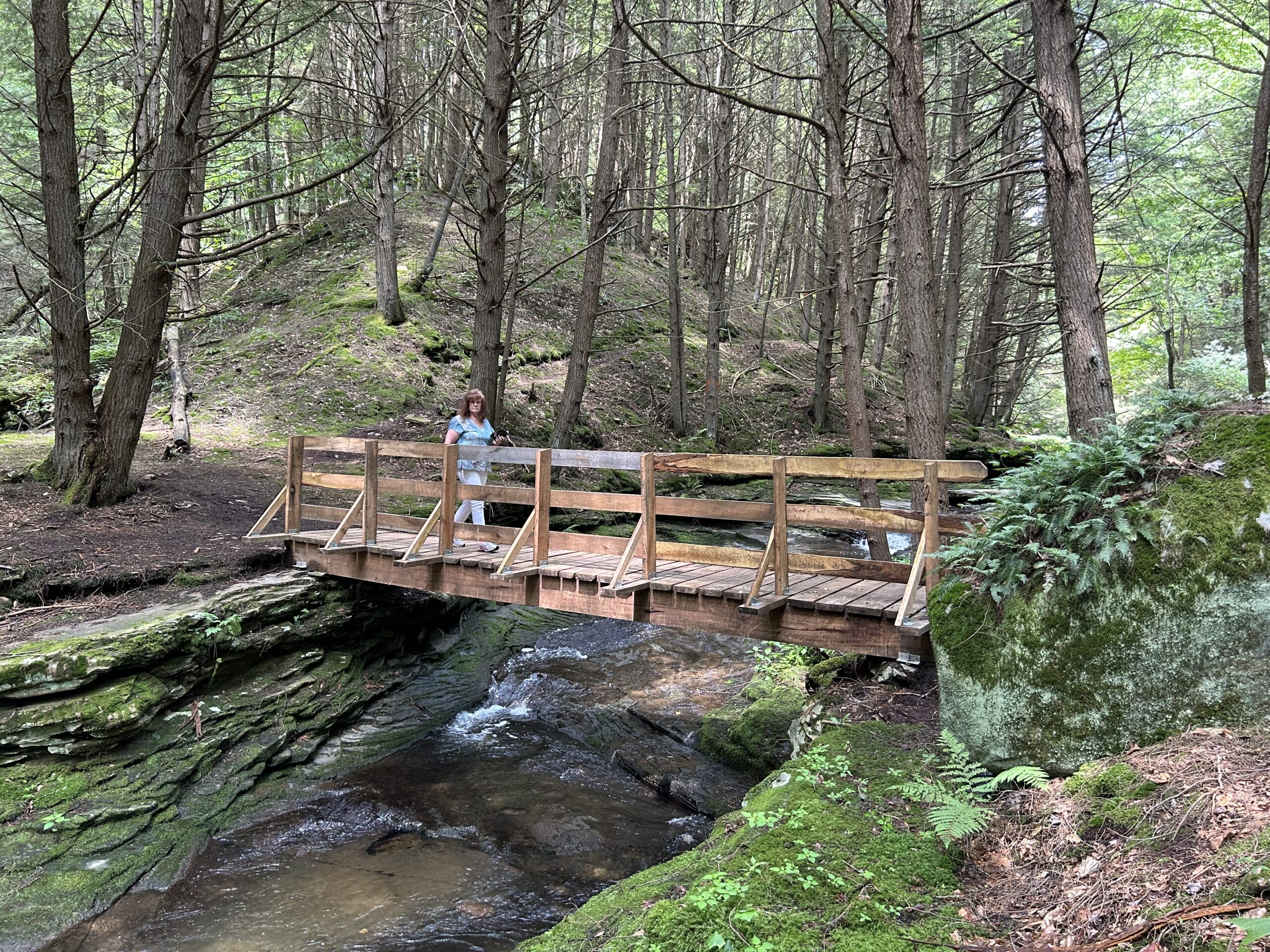I’ll never forget my first time camping out. It was the summer of 1973, and my parents had just bought a brand new Ford Pinto hatchback. It was shimmering dark green with a white leather interior… the ultimate economy SUV of the time. My sister and I especially liked the cavernous back seat, which when folded down, turned into a traveling playroom with a glass ceiling.
I guess it was our new spacious vehicle that sparked Dad to suggest we go camping, something he hadn’t done since his army days, and something mom and us kids had never done.
So we loaded up and headed to the Northumberland County wilderness of Knoebel’s Grove Campground. We were assigned a “secluded” spot in a copse of pines next to 100 other campers and the “Ole Smokey” train tracks.
Photo: Jim hiking along the Mid-State Trail in Lycoming County
It was nearing midnight when the sky flashed and rumbled and started dumping rain, and just three hours past when the Ole Smokey locomotive stopped clacking and tooting, and five minutes past when the cotton candy-wired kids in the neighboring site blew their plastic trumpets for the last time. In ten minutes the deluge swamped mostly collapsed our musty canvas tent. We all scrambled into the Pinto. Sleep deprived and miserable, Dad drove us home at dawn.
In a few weeks, the now mildewed tent was on the curb, and we never went camping as a family again.
I hadn’t been completely soured though, because as a young teenager I gave it another try. My friends and I loved the Robert Redford movie “Jeremiah Johnson”, the sad story of a man trying to survive in the mid 1800’s Rocky Mountain wilderness. In the movie, Johnson slept out in all seasons without a tent, and gathered his food from the land. And so we’d try to imitate him, sometimes purposely heading out to the woods before a predicted heavy snowfall (with a tent), just to fall asleep to the hiss of the snow filling up the forest.
Photo: A bench at the Bradley Wales vista along the West Rim Trail. Photo by Jim Hyland.
Our boundaries expanded once we were old enough to work and drive, and when spring breaks and vacation time presented itself, we headed west to the Rockies and Canyonlands. Once in a real wilderness far from eastern light pollution, we saw what the nighttime sky was supposed to look like. We tried to get as close as we could to experiencing the exhaustion, fear, hunger, and wonder that a man like Jeremiah Johnson must have felt as he faded off to sleep with the grizzly bear and wolf sharing the land under the stars (the very essence of camping).
One particular primitive camping excursion (we were calling it backpacking by then) was to the Black Forest Trail in the wilds of Lycoming County. It was November, and the idea was to hunt for bear while slowly hiking the trail. Schuylkill County was our home, and none of us had been to the Tiadaghton State Forest before, so we didn’t know quite what to expect.
We loved what we found. Although it poured a cold rain most of the time, the terrain we hiked was so rugged and remote that we felt sorry for not discovering it sooner. It was a wilderness that compared well to the West, and was relatively right in our backyards.
Photo: A pile of timber rattlesnakes sunning themselves on the Black Forest Trail. Photo by Jim Hyland.
That was 45 years ago, and the Black Forest, and other nearby trails in the Pennsylvania Wilds have not changed; they are still a wonderful place to hike, explore, and primitive camp under the stars.
Having worked in the Tiadaghton and Tioga State Forests for over 25 years, I can attest to meeting backpackers from all over the world that had come to hike the Black Forest, West Rim, Old Loggers Path, Golden Eagle, Loyalsock, and Mid-State Trails.
Photo: Jim’s wife, Sherry, with their Labrador, Finnegan. Photo by Jim Hyland.
When planning backpacking trips in Pennsylvania and beyond, it is important to remember that the greatest backcountry trails are those that expose a true sense of place. They give hikers a glimpse of cultural and natural history, flora and fauna, regional demographics, current forest management strategies, and of course, scenic beauty.
Pennsylvania Wilds trails offer all of those components. Although hikers won’t see the snow-capped and rugged peaks of Western trails, they will experience the ancient landscape and cultural tapestry that truly represents this region of Pennsylvania.
Photo: A bridge along the Mid-State Trail in Tioga County, with Jim’s wife, Sherry, crossing the bridge. Photo by Jim Hyland.
Regarding camping and hiking ethics, backpackers on PA Wilds trails honor the backcountry camper’s code of ethics called “Leave No Trace”. It is for this reason that it is possible to hike the trails year after year and observe a relatively small degree of human impact.
With the ever-increasing human population, it is really important that all backcountry travelers adopt these simple principles:
You can find more information about the 7 Principles of Leave No Trace and how they relate to traveling in the Pennsylvania Wilds region by visiting PAWilds.com/LNT.
For more information regarding primitive (non-motorized) camping in the Pennsylvania Wilds region, contact the forest district office that manages the trail you’d like to hike. Typically, the knowledgeable staff there can guide you through locations, permitting requirements, etc. Much info can be found online as well at www.dcnr.pa.gov.
Happy Trails!
About the author, Jim Hyland:
Jim Hyland worked his entire career as a DCNR forester in the beautiful north central region of the state. There, he forged a strong appreciation of the people and the woodlands they value and enjoy. Most recently, he was the district forester in the Tioga State Forest, headquartered in Wellsboro, Tioga County. He retired in October 2023. A native of Shenandoah, Schuylkill County, Hyland started his career with the Bureau of Forestry as a Penn State University intern in the Rothrock State Forest District, Centre County. After college, he began working as a forester in Tiadaghton State Forest District, Lycoming County. He was later promoted to Tiadaghton Assistant District Manager and spent two years directing state forest maintenance and recreational programs in the district. Hyland has also served as a Forest Program Specialist with the Bureau’s Division of Operations and Recreation, with emphasis on the Pennsylvania Wilds Region. He was active with the Bureau’s History Committee, and with a love of writing has penned many articles for local newspapers and DCNR publications documenting the lore of north central Pennsylvania and his native coal region, among other topics. Also, he has served as a firefighter and public information officer on many firefighting assignments in the Western U.S. As head of one of 20 state forest districts across the state, Hyland oversaw forest- growth management, personnel coordination, infrastructure maintenance, recreation, and fire prevention and suppression. He also managed service foresters who provide support, direction and technical assistance to private forest landowners. Hyland holds a bachelor’s degree in Forest Management from The Pennsylvania State University. An avid outdoorsman, Hyland enjoys nature writing, woodworking, history, backcountry canoeing and hiking, hunting, fishing, and any type of adventure. Parents of three grown children, he and his wife, Sherry, reside in rural Lycoming County with their Labrador, Finnegan, as well as Ralphie, the calico cat and Kaiser, the African gray parrot.
